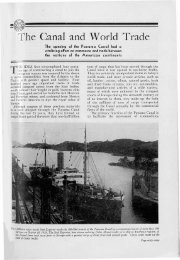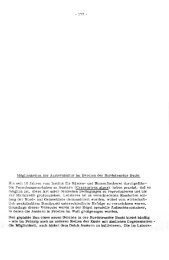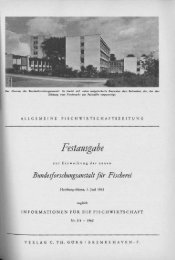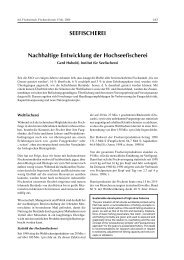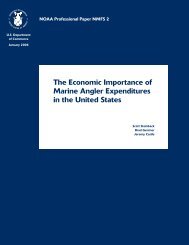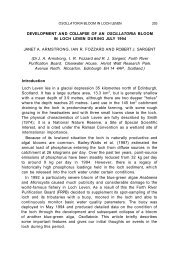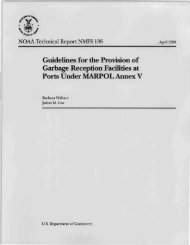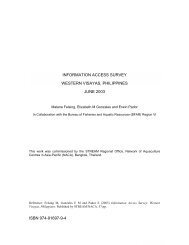Download (1417Kb) - Aquatic Commons
Download (1417Kb) - Aquatic Commons
Download (1417Kb) - Aquatic Commons
You also want an ePaper? Increase the reach of your titles
YUMPU automatically turns print PDFs into web optimized ePapers that Google loves.
2.1<br />
Wilding, J.L. (1940). A new square foot aquatic sampler. Spec. Publs,<br />
limnol. Soc. Am. No. 4, 1-4. [Outer cylinder with sampling area of<br />
929 cm2 is first driven into substratum, then large stones are washed<br />
and removed. Inner cylinder with valve bottom is inserted, then valve<br />
is closed and inner cylinder containing the sample is removed (mesh<br />
size of inner cylinder 9 meshes cm -1 )] S, CL, FW<br />
Withers, J.D. & Benson, A. (1962). Evaluation of a modified Surber bottom<br />
fauna sampler. Proc. W. Va Acad. Sci. 34, 16-20.<br />
2.1 b) Invertebrates on macrophytes<br />
Andrews, J.D. & Hasler, A.D. (1944). Fluctuations in the animal<br />
populations of the littoral zone in Lake Mendota. Trans. Wis. Acad.<br />
Sci. Arts Lett. 35, 175-186. [Plants enclosed by canvas bag with<br />
zip in side to allow operator to reach in and detach plants from bottom;<br />
mouth of bag can be closed so that sample is removed from water;<br />
sampling area 0.5 m2] S, P, FW<br />
But, V.I. (1938). Quantitative drag for the investigation of the benthos<br />
of weed-beds in water-bodies. (In Russian). Dokl. Akad. Nauk SSSR, 14.<br />
[Pair of movable knives are pulled towards pair of fixed knives and<br />
pull a bag of bolting cloth behind them. Sample is thus enclosed in a<br />
bag] S, P, FW<br />
Forsberg, C. (1959). Quantitative sampling of subaquatic vegetation.<br />
Oikos 10, 233-240. [Cuts vegetation from 1 dm2; may also sample<br />
invertebrates but sampler will not prevent some invertebrates from<br />
escaping] S, P, FW<br />
Garnett, P.A. & Hunt, R.H. (1965). Two techniques for sampling freshwater<br />
habitats. Hydrobiologia 26, 114-20. [Cylindrical sampler with<br />
cutting blade at bottom and sampling area of 0.033 m2; modified Ekman<br />
grab with one jaw sharpened and sampling area of 0.050 m2; both<br />
samplers used for sampling molluscs] SR, P, FW<br />
Gerking, S.D. (1957). A method of sampling the littoral macrofauna and<br />
its application. Ecology 38, 219-266. [Box sampler with closing<br />
bottom; plants have to be cut manually] S, P, FW<br />
Gillespie, D.M. & Brown, C.J.D. (1966). A quantitative sampler for<br />
macroinvertebrates associated with aquatic macrophytes. Limnol.<br />
Oceanogr. 11, 404-406. [Plants enclosed in a vertical bag and the<br />
open bottom of the bag is closed with a sliding door fitted with blades;<br />
cutter is operated from above the water surface; sampling area 0.1 m2]<br />
S, P, FW<br />
Grontved, J. (1957). A sampler for underwater macrovegetation in shallow<br />
waters. J. Cons. perm. int. Explor. Msr, 22, 293-297. [Cylindrical<br />
sampler with vertical and horizontal cutters] S, P, FW<br />
Howard-Williams, C. & Longman, T.G. (1976). A quantitative sampler for<br />
submerged aquatic macrophytes. J. limnol. Soc. Sth. Afr. 2, 31-33.<br />
[Rotary cutter with lower blades and hooks to entangle plants; sampling<br />
area 625 cm2; samples to depth of 3 m; designed for sampling macrophytes<br />
but could be used for sessile invertebrates on macrophytes] R, P, FW<br />
11



